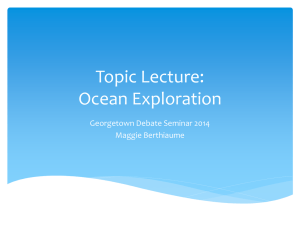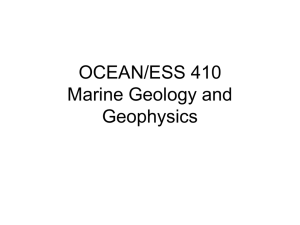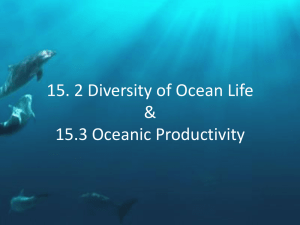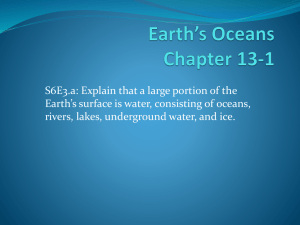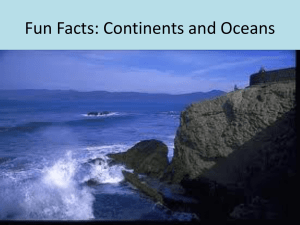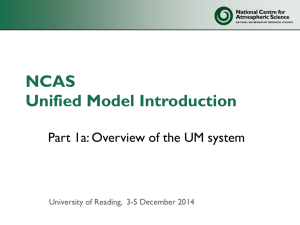Ocean Exploration (2)
advertisement
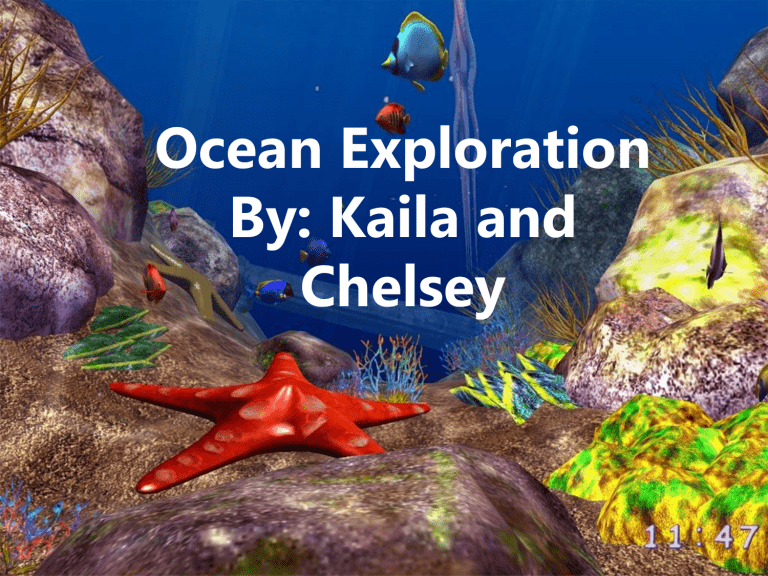
Ocean Exploration By: Kaila and By: Kaila & Chelsey Chelsey What is Ocean Ocean exploration is discovery Exploration? through disciplined, diverse observations and recordings of Ocean exploration is discovery findings. It diverse includes rigorous, through disciplined, observations and recordings of systematic observations and Ocean exploration is discovery through findings. It includes rigorous, disciplined, diverse observations and chemical recordings of documentation of biological, systematic observations and findings. It includes rigorous, systematic physical, geological and archeological documentation of biological, observations and documentation of biological, chemical physical, geological and in the three aspects of the ocean chemical physical, geological and archeological archeological aspects ofspace the dimensions of in dimensions time. aspects of the ocean in theand three of ocean in the three dimensions of space in time. space and and in time. Early History Surveying began at the coastline but slowly inched outward towards the sea. First research included; the studies of tides and tidal currents, the collection of samples to determine characteristics for the anchoring of vessels, and noises, to determine the depth and physical features of water near the coast. * The first people to venture into the sea explored the ocean close to the shore. The Greeks and Chinese were the first societies who went deeper into sea. They were diving into the ocean to gather food and collect shells . * In the mid 1500s, Europe became interested in what was beneath the waves. With crude helmets and diving bells, they were able to spend only a very short time in shallow waters, but they were able to see plants and fish that were not visible from the surface. Surveying began at the coastline but slowly inched outward towards the sea. First research included; the studies of tides and tidal currents, the collection of samples to determine characteristics for the anchoring of vessels, and noises to determine the depth and physical features of water near the coast. * Next, helmets or bells that allowed explorers to spend more time on the the ocean, were developed. The bottom first peopleof to venture into the sea explored the ocean close to the shore . The Greeks and Chinese were . the first societies who went deeper into sea. They were diving into the ocean to gather food and collect shells . midChallenger 1500s, Europe became interested in what was beneath the waves. With crudeof helmets and diving * In the The Expedition was a four-year scientific tour the world's bells, they were able to spend only a very short time in shallow waters, but they were able to see plants and fish thatocean, were notits visible from the surface. oceans in order to gather information about the currents, sea Nextlife, helmets or bells that allowed explorers tocomposition, spend more timeand on thebiology. bottom of Thompson the ocean wereand developed. soundings, the seafloor his The Challenger Expedition was a four-year scientific tour of the world's oceans in order to gather staff discovered over new sea species of ocean life forms as well as information about the ocean,4500 its currents, life, soundings, the seafloor composition, and biology. Thompson and his staff discovered overthe 4500 Marianas new species ofTrench ocean lifeand formsthe as well as underwater features underwater features like Mid-Atlantic Ridge ;ike the Marianas Trench and the Mid-Atlantic Ridge. During the last 60 years, important discoveries about the ocean have helped us learn about life in the ocean. * During the last 60 years, important discoveries about the ocean have helped us learn about life in the ocean. Technology: Robotic Vessels Technology; Robotic Vessels Robotic Vessels are designed to take pictures and videos deep under water. They are remote Robotic Vessels are designed to take pictures and controlled and contains a camera videos deep under They that holds four hourswater. of tape. It are also remote can take up to photos. It Controlled and3000 contains a camera that holds four uses sideofscanning for up to 3000 photos. It hours tape. Itsonars can take locating mineral deposits. also uses side scanning sonarsItfor locating mineral have a profiler thathave can atell us deposits. It also profiler that can tell us how howdeep deepthese thesedeposits depositsare. are. Technology: Submarines Technology; Submarines Submarines are ships that can operate both under and on top of water. A deep diving Submarines are ships that can submarine used to explore the ocean is called a operate both under and on top of water. A deep diving submersible. submarine used to explore the ocean isare called a submersible. Submarines designed for use at great depths, rigid and are double walled. Howthey theyare Work? Their compositionare is designed a mixture for of metal, Submarines use air and water. Air is compressed, and water fills the at great depths, they are rigid and compartments in the ballast tank so that the are double submarine is lesswalled. dense Their than water and able to sink.composition is a mixture of metal, air and water. Air is compressed, and water fills the compartments in the ballast tank so that the submarine is less dense than water and able to sink. Technology: Computer Programs Technology; Computer Programs Not only are simple Not only are simple like diving used to technologies like divingtechnologies used explorethe theocean, ocean, but but more advanced technologies to explore as computer programs are also used. Google more such advanced technologies such Earth as computer enables programs you to look beneath the ocean’s surface are also Google Earth and used. explore wild-life andcoral reefs. enables you to look beneath the ocean’s surface and explore wild-life and coral reefs. Jacques Cousteau created one of the first underwater methods of breathing, he called it the “Aqua-Lung”. The “Aqua-Lung” is a device created to allow divers to dive deeper for longer periods of time. It was made of a regulator and three cylinders of air. The future of Ocean Exploration The Sea Orbiter The Sea Orbiter will be the world’s first vertical ship 51m high it will allow man a view of life below the surface. It is still only a prototype invented by Jacques Rougerie but will soon become a reality. The Sea Orbiter will provide a permanent mobile presence with windows under the surface of the sea. It will cost £32million to build the first Sea Orbiter. As well as ocean exploration the Sea Orbiter would also be a useful tool for studying the link between global warming and the oceans. The future of Ocean Exploration The future of ocean exploration Along with advantages comes disadvantages. Over exploration Over exploration of the world’s aquatic life and of the ocean can destroy ecosystems will create serious damage in the future. ecosystems asocean well bordering as aquatic Tourism in countries creates more life.and Another disadvantage more exploitation and is pollution. in ocean pollutionTourism in normally bordering countries creates more human-free environments. and more exploitation and Over exploring the ocean will pollution in normally human-free lead to damaged ecosystems environments. and wild life. http://ksuvirtual2.geog.kent.edu/earthfromspace/presentations/Ocean%20satellites_files/frame.htm#sli de0001.htm http://www.boddunan.com/computers-a-technology/37-new-technologies/8668-new-robotic-vesselextends-deep-ocean-exploration.html http://www.ocean-explorers.com/oceanx/b_on/oe_vessl.htm http://www.islandnet.com/~yesmag/how_work/submarine.html http://www.seasky.org/oceanxp/sea5a3.html http://dels.nas.edu/dels/rpt_briefs/exploration_final.pdf http://goliath.ecnext.com/coms2/gi_0199-5231082/Our-blue-planet-ocean-exploration.html http://www.youtube.com/watch?v=6ATw1f_qcEg http://dels.nas.edu/dels/rpt_briefs/exploration_final.pdf http://science.jrank.org/pages/7096/Underwater-Exploration-Diving-toolstechniques.html#ixzz0exRg5lCZ http://oceanexplorer.noaa.gov/history/early/early.htm http://img.nauticexpo.com/images_ne/photo-g/service-vessel-pilot-boat-193738.jpg http://thewere42.files.wordpress.com/2009/08/submersibles-ocean-explore.jpg

